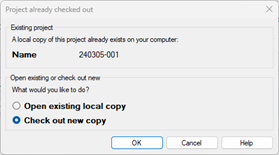File export troubleshooting guide
Having difficulties with exporting? Here you can find solutions grouped into categories.
If the first one doesn’t solve the issue, move to the next.
Make sure to export the bilingual MQXLZ file before reimporting any source file. This will be useful for our support team in case all solutions fail.
First category: The Export (stored path) option
Scenario: You're a translator working on the checked-out version of a server project. You aren't the one who uploaded the document on the server.
In such a case, always use the Export (Choose Path) option. The Export (Stored Path) option will not work.
Second category: File path too long
Scenario: You're trying to export a document from a checked-out server project, but some files are deeply nested in your folder structure.
If this happens, make sure the project name or file name isn’t too long. They must stay under Windows’ 260-character file path limit. If they’re too long, the export won’t work.
To fix this issue:
-
First, sync your checked-out project.
-
Then, check out the project again and make sure to shorten its name significantly in the Project name field.
-
In the following dialog, click Check out new copy.

-
Try to export the file.
-
If it still doesn’t work, ask your Project Manager to export the document directly from the server.
Third category: Missing tags or tag errors
Scenario: Your export failed due to missing tags in either the source or target language.
To fix tag-related issues:
-
Run the QA check and fix all errors and tag-related warnings (including those that might have been ignored the first time).
Try using specific QA settings to check tags only, then export the document again. If it still doesn’t work, move to step 2.
-
If Track Changes is turned on, check the target segments. It is possible that some tags were removed in track change mode.
If that's the case, accept those changes. If that doesn’t work, go to step 3.
-
In the failed export error message, find the segment number that is causing the export to fail.
-
Check tags (e.g., hyperlinks [hnlk]) around the specified segment. It's possible that some important tags were removed in one of the source segments. Make sure to check 10 previous and the 10 following segments because the segment number visible in the error message may not be accurate.
-
If that is the case, reimport the document with the same filter.
-
X-Translate and fix segments that aren't X-Translated.
-
Try to export. If it still doesn’t work, go to step 4.
-
-
Duplicate the source file.
-
First, give the file another file name and import into memoQ.
-
Then, copy source to target (don't confirm anything in the TM) and try to export.
-
If it works, pre-translate this new document with the project working TM only, and fix segments that aren't context matches.
-
If it fails, it means the issue lies within the document or within memoQ TMS. So move to the next category.
-
Fourth category: Filter issues or memoQ issues
Scenario: It turned out that all the above solutions don't work. It seems that the issue lies withing the document or memoQ TMS.
To fix filter or build-related issues:
-
Try a similar file type.
-
Save the original document in a similar file type (e.g., DOCX to DOC, PPTX to PPT).
-
Reimport the document, X-Translate, and fix segments that are not X-Translated.
Do that only if you are sure you won’t lose any content in the process. For example, SmartArt content in Word 2007+ and PowerPoint 2007+ will be converted to pictures in Word 97-2003 PowerPoint 97-2003.
-
Try to export this new document. If it works, don’t forget to save back the translation in the original file type.
-
If the export fails, go to step 2.
-
-
Try an original file type.
-
Save the original document back to its original file type.
-
Reimport the document, X-Translate, and fix segments that aren't X-Translated.
-
Try to export this new document. If the export fails, go to step 3.
-
-
You've upgraded to a new memoQ version between the time the project was created and completed?
-
Create a new memoQ project and import the document in its original format.
-
Copy source to target.
-
Try to export it.
-
If the file exports, the next step is to pre-translate the file from the previous version.
How to do that?
-
Go back to the original project you translated.
-
Create a new translation memory (simple sontext) and making it primary.
-
Confirm and update all rows of the document into that new TM.
-
Go back to the new project you created, and pre-translate the file with the newly created TM.
-
Fix segments that aren't 101% matches (empty segments, missing tags, etc.).
If the file doesn’t export, move to step 4.
-
-
-
Ask our Support team for help
To help you our support team need a few things:
-
The original file and the memoQ bilingual file (you can export it sing the Export bilingual option, and then selecting memoQ XLIFF).
-
Make sure to follow all the best practices of contacting our Support team.
-